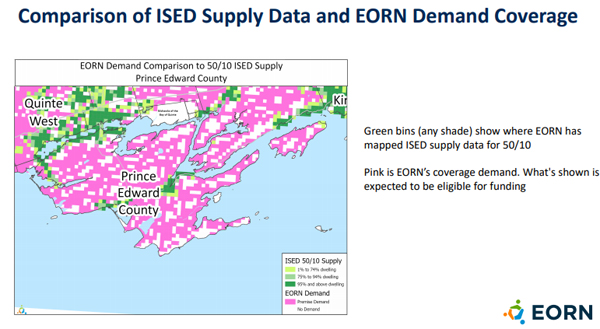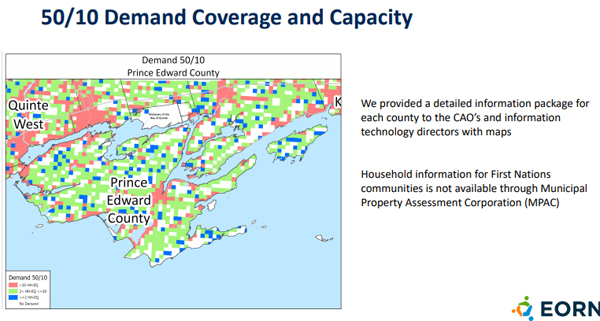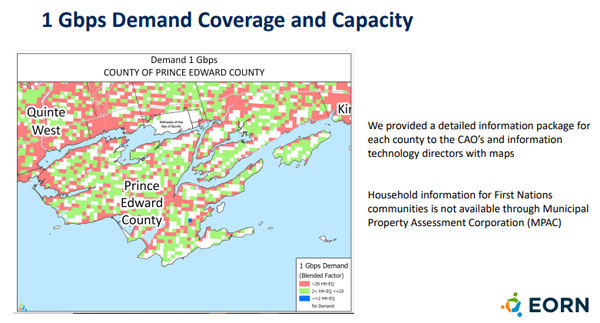Long way to go yet to have quality rural internet
Administrator | Sep 24, 2020 | Comments 6
Amid a meeting of council sprinkled with connection issues for participants, David Fell, of the Eastern Ontario Regional Network (EORN), said there’s still a long way to go for quality internet for most residents.
Receiving his update for information, not for a decision, councillors noted the need for quality home internet has intensified for people working, or attending school, during the COVID-19 pandemic.
They spoke specifically about many constituents who have snail speed internet, and to cell phone and online difficulties in the County, where quality service is mostly limited to its urban centres.
The Canadian Radio-television and Telecommunications Commission (CRTC)
aspirational goal is that 90 per cent of all Canadians have access to broadband at speeds of at least 50 Mbps download and 10 Mbps upload (50/10 Mbps) by December 2021.
Fell said the EORN 2019 analysis shows that currently, just 46 per cent of EOWC rural homes and businesses have access to 50/10 Mbps. That rises to just over 60 per cent when urban centres are added.

Fell presented the EORN cell gap update to committee of the whole Thursday afternoon.
“Even though there may be coverage in an area, there may not be sufficient resources to handle the traffic load generated by the numbers of people served by the cell network in a local area,” he said. “Service levels can be impacted by adverse weather, high rates of local data usage, unusually high number of users in a local area and other factors,” he said, noting capacity design will help address the issues.
EORN’s project goals are to achieve 99 per cent coverage in eastern Ontario to make and receive voice cell phone calls and 95 per cent coverage with standard definition service which can support email, web browsing and social media services. It seeks 85 per cent coverage with high definition service which can support video conferencing, movie streaming and other more data intensive applications.
 Fell stated a $500-to-$750 million cost to bring 50/10 Mbps to 95 per cent of the demand across the region (using a mixture of 75 per cent wireline (1Gbps capable) and 20 per cent fixed wireless across the region for a minimum of 90 per cent of each county’s demand.
Fell stated a $500-to-$750 million cost to bring 50/10 Mbps to 95 per cent of the demand across the region (using a mixture of 75 per cent wireline (1Gbps capable) and 20 per cent fixed wireless across the region for a minimum of 90 per cent of each county’s demand.
Prince Edward County’s estimated cost would be $13,314,199.
 Estimated cost to bring the faster 1 Gbps service to 95 per cent of the demand across the region using a wireline is $1.2-to-$1.6 billion.
Estimated cost to bring the faster 1 Gbps service to 95 per cent of the demand across the region using a wireline is $1.2-to-$1.6 billion.
Prince Edward County’s estimated cost would be $40,842,590.
Fell noted the variable in range of cost estimates is access to utility poles and pole replacement costs, and is based on a mid range of approximately $30 per meter for fibre.
Funding partners so far to tally $213 million include the Eastern Ontario Wardens’ Caucus and Eastern Ontario Mayors’ Caucus ($10 million); Canada and Ontario at $71 million each and a request for proposal that closed Sept. 3 to telecom service providers out for $61 million.
Prince Edward County has so far invested $300,000, and is committed to $500,000.
Construction could start in 2021 with a build out of the project over five years, he said, with contract monitoring to 2030.
On June 4, 2020 the EORN board endorsed and directed EORN to pursue a 1 Gig project for Eastern Ontario. The EORN will continue to advocate with the provincial and federal governments and expects it could have a request for proposal in place for the region by February 2021.
Replies from Bell and Rogers to a request for proposal are currently being reviewed.
Councillors noted a fixed broadband service to all homes would go a long way to helping those who are currently finding themselves in great need.
Fell said EORN is aiming for the faster rates as technology advances quickly. Broadband system equipment, he said, needs to be upgraded every five years while fibre technology has a 20-25 year lifespan.
Fell added municipalities can help by providing land for telecom service providers to consider tower builds; have tower siting plans in place and expedite permits.
Filed Under: Local News
About the Author:
































In my view, Starlink, which will use thousands of near-earth satellites, is the only hope for the near term. In beta tests to date, it is providing 50 Mbps download speed with very low latency. It will be available to everyone in rural areas with a view of the northern sky. There is no way that the County can afford $40M for wired Internet, leaving 5% without.
Speed and availability is certainly an issue however pricing is equally as large an issue. No point having something available that is priced to high each month to afford.
Is Starlink a potential solution for slow internet speeds in the County?
The county might be able to save some money if Starlink by SpaceX provides coverage.
Starlink is Elon Musks low orbit satellite internet service. SpaceX has invested $10 billion to bring high speed internet to rural communities across the globe. Elon confirmed that Starlink will be available in Canada and supposedly trials are taking place in Canada as you read this.
Maybe if enough people signup for the waitlist Starlink will position a few above the county. 🙂
Fibre everywhere is too expensive. We need high speed now, not in 10 years.
Starlink is the solution: https://www.starlink.com/
What we need is political pressure on the CRTC to get this approved, and we will have low latency, high speed internet everywhere. PEC should join the Federation of Northern Ontario (FONOM) in their fight for CRTC license approval:
https://www.iphoneincanada.ca/news/spacex-starlink-internet-northern-ontario/
As someone in the data utilization field, there are disheartening news!
If the recent lockdown status could prove anything, is that the three main rural Internet providers cannot cope with demand, as they have oversold their net capacities.
Some local providers are making headway against these providers.
Are there any considerations in funding proof of concept strategies?
For example, Tri-Canadian Energy Communications has moved my household from a dismal 1/1Mbps connection with one of the established providers to a steady 20/10 Mbps connection.